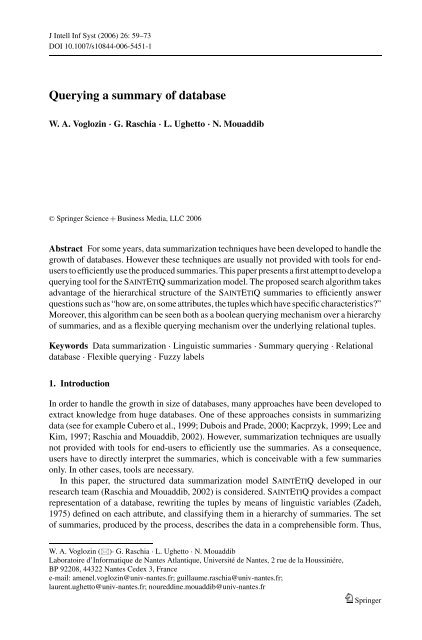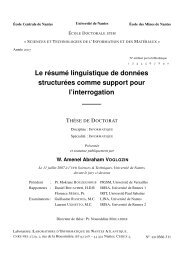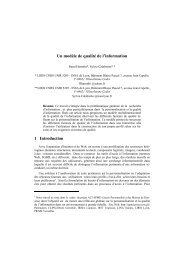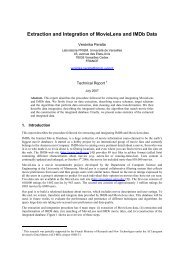Create successful ePaper yourself
Turn your PDF publications into a flip-book with our unique Google optimized e-Paper software.
J Intell Inf Syst (2006) 26: 59–73DOI 10.1007/s10844-006-5451-1<strong>Querying</strong> a <strong>summary</strong> <strong>of</strong> <strong>database</strong>W. A. Voglozin · G. Raschia · L. Ughetto · N. MouaddibC○ Springer Science + Business Media, LLC 2006Abstract For some years, data summarization techniques have been developed to handle thegrowth <strong>of</strong> <strong>database</strong>s. However these techniques are usually not provided with tools for endusersto efficiently use the produced summaries. This paper presents a first attempt to develop aquerying tool for the SAINTETIQ summarization model. The proposed search algorithm takesadvantage <strong>of</strong> the hierarchical structure <strong>of</strong> the SAINTETIQ summaries to efficiently answerquestions such as “how are, on some attributes, the tuples which have specific characteristics?”Moreover, this algorithm can be seen both as a boolean querying mechanism over a hierarchy<strong>of</strong> summaries, and as a flexible querying mechanism over the underlying relational tuples.Keywords Data summarization · Linguistic summaries · Summary querying · Relational<strong>database</strong> · Flexible querying · Fuzzy labels1. IntroductionIn order to handle the growth in size <strong>of</strong> <strong>database</strong>s, many approaches have been developed toextract knowledge from huge <strong>database</strong>s. One <strong>of</strong> these approaches consists in summarizingdata (see for example Cubero et al., 1999; Dubois and Prade, 2000; Kacprzyk, 1999; Lee andKim, 1997; Raschia and Mouaddib, 2002). However, summarization techniques are usuallynot provided with tools for end-users to efficiently use the summaries. As a consequence,users have to directly interpret the summaries, which is conceivable with a few summariesonly. In other cases, tools are necessary.In this paper, the structured data summarization model SAINTETIQ developed in ourresearch team (Raschia and Mouaddib, 2002) is considered. SAINTETIQ provides a compactrepresentation <strong>of</strong> a <strong>database</strong>, rewriting the tuples by means <strong>of</strong> linguistic variables (Zadeh,1975) defined on each attribute, and classifying them in a hierarchy <strong>of</strong> summaries. The set<strong>of</strong> summaries, produced by the process, describes the data in a comprehensible form. Thus,W. A. Voglozin ()· G. Raschia · L. Ughetto · N. MouaddibLaboratoire d’Informatique de Nantes Atlantique, Université de Nantes, 2 rue de la Houssiniére,BP 92208, 44322 Nantes Cedex 3, Francee-mail: amenel.voglozin@univ-nantes.fr; guillaume.raschia@univ-nantes.fr;laurent.ughetto@univ-nantes.fr; noureddine.mouaddib@univ-nantes.frSpringer
60 J Intell Inf Syst (2006) 26: 59–73each <strong>summary</strong>, expressed with fuzzy linguistic labels, symbolizes a concept that exists withinthe data.This paper proposes a querying mechanism for users to efficiently exploit the hierarchicalsummaries produced by SAINTETIQ. The first idea is to query the summaries using the vocabulary<strong>of</strong> the linguistic variables defined for the summarization process. Although linguisticterms are used in the expression <strong>of</strong> queries, the querying process is clearly boolean. Since thequerying vocabulary is the one used within the summaries, the linguistic terms have becomethe attribute values in the summaries and query answers contain these linguistic terms only.Then, basic queries such as “how are, on attribute(s) A k , the tuples which are d i, j on A i ”(e.g., “what is the hardness <strong>of</strong> metals whose fusion temperature is high”), can be answeredvery efficiently as the querying process relies on boolean operations. Moreover, the algorithmtakes advantage <strong>of</strong> the hierarchical structure <strong>of</strong> the summaries, which also works as a kind <strong>of</strong>multidimensional index, in order to obtain the answer more rapidly. The gain is particularlyimportant in case <strong>of</strong> a null answer, as only a small part <strong>of</strong> the summaries hierarchy has to beexplored, instead <strong>of</strong> the entire relation.<strong>Querying</strong> the summaries as explained above is interesting as it makes it possible to rapidlyget a rough idea <strong>of</strong> the properties <strong>of</strong> tuples in a relation. In case <strong>of</strong> null answers, it clearlysaves time: examining the top <strong>summary</strong> <strong>of</strong> a hierarchy is enough to know there is no answerfor an empty result set query. Suppose for instance that one can access several <strong>database</strong>s.<strong>Querying</strong> their summaries can allow to rapidly determine which ones are likely to give ananswer.In other cases, a rough answer is <strong>of</strong>ten not enough. Thus, the second idea is to query the<strong>database</strong> through the summaries, which would be done by 1—selecting some summaries fromthe <strong>summary</strong> hierarchy w.r.t. criteria specified by the query and 2—retrieving the <strong>database</strong>records’ identifiers from the selected summaries. This process is then related to the “flexiblequerying <strong>of</strong> relational <strong>database</strong>s” trend <strong>of</strong> research. Indeed, in this case, linguistic terms areused in the expression <strong>of</strong> queries, and the answer would be composed <strong>of</strong> tuples from theoriginal relation, ranked according to a degree <strong>of</strong> satisfaction to the query.The next section describes flexible queries <strong>of</strong> <strong>database</strong>s and their features compared toclassical queries. It exposes some earlier works done in this field by other researchers. Section3 presents an overview <strong>of</strong> the SAINTETIQ model, briefly depicting the representations <strong>of</strong>summaries and the different steps <strong>of</strong> the <strong>summary</strong> building process. It also highlights thedistinctive aspects <strong>of</strong> our approach. Section 4 thoroughly explains how advantage can betaken from the use <strong>of</strong> the SAINTETIQ summaries hierarchies in a flexible querying process.Expression <strong>of</strong> queries, selection <strong>of</strong> summaries and formation <strong>of</strong> results are then reviewed.2. Flexible querying <strong>of</strong> regular <strong>database</strong>sA flexible querying process operating on relational <strong>database</strong>s searches the tuples for adequacyto a query using an extension <strong>of</strong> a standard language, usually SQL. According to Larsen(1999), a flexible querying process <strong>of</strong> a <strong>database</strong> can be divided in three steps: extension <strong>of</strong>criteria, selection <strong>of</strong> results and ordering.The first step uses similarity between values to extend the criteria, i.e. to allow gradedsemantics for any criterion, which can now express “around 20” instead <strong>of</strong> being limited tothe binary semantics <strong>of</strong> “equal to 20” or “between 18 and 22”. The second step, namely theselection <strong>of</strong> results, determines which data will participate in the answer to the query. Thesedata are afterwards referred to by the term “results”: the set <strong>of</strong> all results constitute the answerto a query. The last step (ordering) follows from the extension <strong>of</strong> criteria. It discriminatesSpringer
J Intell Inf Syst (2006) 26: 59–73 61among the results on the basis <strong>of</strong> their relative satisfaction to the graded semantics: a value<strong>of</strong> 20 is better ranked than a value <strong>of</strong> 18.The fuzzy set theory is <strong>of</strong>ten used in flexible querying (see Dubois and Prade, 1997)because it provides a formal framework to handle the graduality and vagueness inherent tonatural language. The following works, which are representative <strong>of</strong> the research on flexibilityin <strong>database</strong> querying, exemplify the use <strong>of</strong> fuzzy sets. They are essentially characterized bya tuple-oriented processing, the possibility to define new terms and especially, the use <strong>of</strong>satisfaction degrees.2.1. SQLfThe querying language SQLf, proposed by Bosc and Pivert (1994), is an extension <strong>of</strong> SQLaiming at “introducing fuzzy predicates into SQL wherever possible”. An augmentation <strong>of</strong>both the syntax and semantics <strong>of</strong> SQL is performed so that most elements <strong>of</strong> a query can befuzzified. These elements include operators, aggregation functions, modifiers (very, really,more or less), quantifiers (most, a dozen) as well as general description terms such as youngor well-paid.Different interpretations are possible for the same query, for instance fuzzy sets crispcardinality or Yager’s ordered weighted averaging operators (Yager, 1988). It occurs for eachrecord and yields a grade <strong>of</strong> membership (<strong>of</strong> the record to the query) which is used to rankthe results. An example <strong>of</strong> query in SQLf is “select 10 dpt from EMPLOYEE group bydpt having most-<strong>of</strong> (age = young) are well-paid” where standard SQL keywords are inbold face, and dpt and age are attributes from a relation named EMPLOYEE. The queryselects the 10 departments which have the best satisfaction <strong>of</strong> the condition “most <strong>of</strong> theyoung employees are well-paid”.2.2. FQUERYFQUERY (Kacprzyk and Zadro«zny, 2001) is an integration <strong>of</strong> flexible querying into anexisting <strong>database</strong> management system, namely Micros<strong>of</strong>t Access. The system allows querieswith vague predicates expressed through fuzzy sets. Queries may contain linguistic quantifiersand attach different levels <strong>of</strong> importance to attributes. In doing so, the authors try to applythe computing with words paradigm and, eventually, deal with linguistic values, quantifiers,modifiers and relations.FQUERY uses fuzzy sets for the imprecision aspect and performs a syntax and semanticsextension <strong>of</strong> SQL. Linguistic values and quantifiers are represented as fuzzy sets. On thesemantics side, the query is considered as a fuzzy set resulting from the combination <strong>of</strong>fuzzy sets from linguistic values and quantifiers. Accordingly, each record selected by aclassical SQL query, has a satisfaction degree used in a ranking step since it indicates howwell the record corresponds to the query.2.3. SummarySQLDeveloped by Rasmussen and Yager (1997), SummarySQL is a fuzzy query language intendedto integrate summaries into a fuzzy query. The language can evaluate the truth degree<strong>of</strong> a <strong>summary</strong> guessed by the user. It can also use a <strong>summary</strong> as a predicate in a fuzzy query.A <strong>summary</strong> expresses knowledge about the <strong>database</strong> in a statement under the form “Qobjects in DB are S”or“QRobjects in DB are S”. DB stands for the <strong>database</strong>, Q is a linguisticSpringer
62 J Intell Inf Syst (2006) 26: 59–73quantifier and R and S are summarizers (linguistic terms). One can obtain statements like“most people in DB are tall” or“most tall people in DB are heavy”.Predicates (i.e. summaries) and linguistic terms are fuzzy sets in the expression that representsthe selection condition. The expression is evaluated for each tuple and the associatedtruth values are later used to obtain a truth value for the <strong>summary</strong>. SummarySQL is used todetermine whether, or to what extent, a statement is true. It can also be used to search forfuzzy rules.2.4. FSQLFSQL (Galindo, 1998) is an extension <strong>of</strong> SQL in which all SQL expressions are valid.The language is available through a client-server architecture in which the server s<strong>of</strong>twareaccesses an Oracle <strong>database</strong>. SQL is extended to allow flexible conditions using linguisticlabels, fuzzy comparison operators, fuzzy constants and many other fuzzy constructs. Forinstance, a fuzzy quantifier can be specified in the language’s metaknowledge base by givingthe four values that define a trapezoidal possibility distribution. Each condition in a querycan be given a threshold that sets the minimum satisfaction degree for the condition. FSQLdoes not limit flexibility to the SELECT clause. INSERT, UPDATE and DELETE are alsosupported.FSQL is remarkable in two aspects. First, the wide variety <strong>of</strong> flexible constructs that areavailable and second, it is one <strong>of</strong> the very few, it not the only, fuzzy extensions <strong>of</strong> SQLimplemented over an existing <strong>database</strong> management system.3. <strong>Querying</strong> the SaintEtiQ summariesThe targeting <strong>of</strong> <strong>database</strong> records in flexible queries may lead to prohibitive response timeswhen a large number <strong>of</strong> records is involved, or when subqueries are employed. Waiting foran answer for a long time is frustrating, particularly when the query fails (that is, it has nomatching record in the dataset).Database summaries <strong>of</strong>fer a means for significantly reducing the volume <strong>of</strong> input for processesthat require an access to the <strong>database</strong>. The response time benefits from the downsizing.Furthermore, for this querying process, performance does not depend on specific combinations<strong>of</strong> attributes, i.e., whether the attributes are indexed or not, since these summaries aregeneral indexes for the underlying data (Raschia, 2001).When querying the summaries, the response time gain is made clearly at the expense<strong>of</strong> a loss <strong>of</strong> precision in the answer. This is <strong>of</strong> no importance when only a rough answer isrequired. This can be the case for instance when querying a medical <strong>database</strong> for anonymous,statistical information. Indeed, precise information can violate medical confidentiality. Theloss <strong>of</strong> precision is also <strong>of</strong> no importance when a request only aims at determining the absence<strong>of</strong> information in a <strong>database</strong>. As already said, this is the case when one wants to know if a<strong>database</strong> is likely to answer the query.When more details about the tuples are needed, querying the summaries is a first step only:the entire set <strong>of</strong> relevant tuples can be easily retrieved from the answer summaries. The queryingmechanism remains efficient, and there is no loss <strong>of</strong> precision in the answer. However,the loss is in the querying language expressiveness. At present, only the linguistic variablesused to build the summaries hierarchy can be used in the expression <strong>of</strong> the queries. Moreover,as the generated summaries can be considered as one table in the <strong>database</strong> relational model,Springer
64 J Intell Inf Syst (2006) 26: 59–73Table 1 Part <strong>of</strong> theMATERIALS table Materials Tuple TranslationUZ40 t a =〈10, 38, 900〉 t a1 =〈0.7/medium, 1.0/s<strong>of</strong>t,0.85/moderated 〉CuSn12 t b =〈8, 40, 850〉 t b1 =〈0.35/medium, 0.9/s<strong>of</strong>t,1.0/moderated 〉,t b2 =〈0.35/thin, 0.9/s<strong>of</strong>t,1.0/moderated 〉CuAs05 t c =〈12, 44, 896〉 t c1 =〈1.0/medium, 0.4/s<strong>of</strong>t,0.9/moderated 〉,t c2 =〈1.0/medium, 0.4/hard,0.9/moderated 〉Fe t d =〈10, 35, 1530〉 t d1 =〈0.7/medium, 1.0/s<strong>of</strong>t,0.85/normal 〉Ni t e =〈5, 35, 1453〉 t e1 =〈1.0/thin, 1.0/s<strong>of</strong>t,0.96/normal 〉... ... ...Fig. 2 Part <strong>of</strong> a <strong>summary</strong>hierarchy for MATERIALSt e .thickness = 5 mm is expressed as t e1 .thickness ={1.0/thin} where 1.0 tells howwell the label thin describes the value 5mm(1.0 is the satisfaction degree <strong>of</strong> thin by 5mm).Applying this mapping to each attribute <strong>of</strong> a relation corresponds to a translation <strong>of</strong> the initialtuple into another expression called a candidate tuple.One attribute value may be described by more than one fuzzy label (e.g. 8mmis describedby medium and thin). It follows that one tuple (for instance t b and t c in Table 1) may yieldmany candidate tuples.Second, each candidate tuple is incorporated into the growing hierarchy and reaches a leafnode where other candidate tuples with the same labels are stored. This can be seen as a classification<strong>of</strong> the candidate tuple. It is important to notice that the tree is modified throughoutcandidate tuples incorporation: it progressively becomes a complete representation <strong>of</strong> thedata. Its evolution is partly controlled by learning operators (see Raschia, 2001) that try tomaximize the inner-class similarity and the inter-class dissimiliarity.An analogy could be that the hierarchy <strong>of</strong> summaries is a network <strong>of</strong> pipes with a singleentry point at the top and several outlets to a set <strong>of</strong> buckets at the bottom, one outlet perbucket. Candidate tuples can be seen as objects <strong>of</strong> different types. From the entry, an object isdirected to the bucket it belongs to. But through the process <strong>of</strong> reaching the adequate bucket,it creates some structural modifications in the network <strong>of</strong> pipes so some craftsmen (that is, thelearning operators) have to constantly adapt the network. Some junctions are made thinneror larger, some pipes are added or deleted, etc... In the end, all objects <strong>of</strong> the same type aredispatched into buckets and the lengths <strong>of</strong> paths to the buckets are minimal. Each bucket thatSpringer
J Intell Inf Syst (2006) 26: 59–73 65Table 2 Description <strong>of</strong> some summariesSummary Intension Coverz 3 〈 1.0/medium, 1.0/s<strong>of</strong>t, 1.0/moderated 〉 t a1 , t b1 , t c1z 4 〈 0.7/medium, 1.0/s<strong>of</strong>t, 0.85/normal 〉 t d1z 5 〈 0.35/thin, 0.9/s<strong>of</strong>t, 1.0/moderated 〉 t b2z 6 〈 1.0/medium, 0.4/hard, 0.9/moderated 〉 t c2z 7 〈 1.0/thin, 1.0/s<strong>of</strong>t, 0.96/normal 〉 t e1z 1z 2z 0〈 1.0/medium,1.0/s<strong>of</strong>t,1.0/moderated + 0.85/normal 〉 z 3 , z 4〈 1.0/thin + 1.0/medium,1.0/s<strong>of</strong>t + 0.4/hard,1.0/moderated + 0.96/normal 〉 z 5 , z 6 , z 7〈 1.0/thin + 1.0/medium + 0.7/thick,1.0/s<strong>of</strong>t + 0.4/hard,1.0/moderated + 0.96/normal + 0.75/high 〉 z 1 , z 2is not empty at the end after all objects have been through the network <strong>of</strong> pipes is labeledwith a description <strong>of</strong> its contents.From the semantic point <strong>of</strong> view, a <strong>summary</strong> is a concept, a set <strong>of</strong> records which aresimilar when rewritten with the terms from the linguistic variables. If the user had to describethe records in the <strong>database</strong> using the vocabulary they have provided, they would have giventhe same descriptions many times for different records. Instead <strong>of</strong> repeating these instances,a <strong>summary</strong> reflects each description once, keeping track <strong>of</strong> what records share the samedescription.In the hierarchy structure, a level (i.e., a depth in the tree <strong>of</strong> summaries) can be associatedwith the relative proportion <strong>of</strong> data a <strong>summary</strong> describes: the deeper the <strong>summary</strong> in the tree(or the lower its level in the hierarchy), the finer the granularity. It follows that the lowestlevels (the leaves) contain the most precise and specific summaries. Such summaries canbe expressed in the same way as candidate tuples: z =〈α 1 /d 1 ,α 2 /d 2 ,...,α n /d n , 〉. Thisexpression is called the intension or intensional expression <strong>of</strong> the <strong>summary</strong>. It is an importantpoint to note that there is only one label per attribute in the leaf summaries (see z 3 in Table2). Moreover, an initial relational tuple can correspond to several leaves.By contrast, the root <strong>of</strong> the tree is the most general <strong>summary</strong> as it covers all the data. Theintensional expression <strong>of</strong> non-leaf summaries has one or more multi-labeled attributes (e.g.z 1 and z 2 ). This depends on the labels in candidate tuples covered by the summaries. Thus,in these intermediate-level summaries (the non-leaf nodes <strong>of</strong> the hierarchy tree), the labelsare obtained by just the union <strong>of</strong> the labels <strong>of</strong> the children summaries.4. Description <strong>of</strong> the querying processAs stated in Section 2, the first step <strong>of</strong> a <strong>database</strong> flexible querying process consists inextending selection criteria. The linguistic variables used in SAINTETIQ already perform thecriteria extension task prior to the actual summarization process. As a consequence, binaryinclusion operators can be used to identify the summaries (and also, the relational data)Springer
66 J Intell Inf Syst (2006) 26: 59–73to be considered as results to a query; there is no need for special operators to deal withthe computation-intensive task <strong>of</strong> extending criteria. This section deals with all aspects <strong>of</strong>selection from the expression and meaning <strong>of</strong> a query to its matching with summaries.4.1. Expression <strong>of</strong> a queryThis approach to flexible querying intends to answer questions such as “how are thin materials?”or “how are normal-temperature and s<strong>of</strong>t-hardness materials ?”. In the prototypedeveloped for querying, the questions are expressed using a user-friendly interface that composesthe corresponding query in an SQL-like language. For the two previous questions, thequeries are respectively:Q 1 : SELECT temperature, hardness FROM MATERIALSWHERE thickness IN ("thin")Q 2 : SELECT thickness FROM MATERIALSWHERE temperature IN ("normal") AND hardness IN ("s<strong>of</strong>t")For a more formal expression <strong>of</strong> a query, let:– S be a set <strong>of</strong> attributes;– R(S) be the relation whose tuples are summarized;– Q be a query (e.g., Q 1 and Q 2 in the above example);– A i , i ∈{1,...,n} be an attribute appearing in the query (A i ∈ S);– d i, j , j ∈{1,...,m} be a label (or descriptor) <strong>of</strong> attribute A i , also appearing in the query.In a query, descriptors (like thin, normal or s<strong>of</strong>t in Q 1 and Q 2 ) are called “required characteristics,”and embody the properties that a record must have to be considered as an element<strong>of</strong> the answer.A query also defines the attributes for which required characteristics exist. The set <strong>of</strong> theseinput attributes is denoted by X. The expected answer is a description over a set <strong>of</strong> otherattributes, denoted by Y . Without further precision, Y is the complement <strong>of</strong> X relatively toS: X ∪ Y = S and X ∩ Y =∅.Hence a query defines not only a set X <strong>of</strong> input attributes A i but also, for each attributeA i , the set C Ai <strong>of</strong> its required characteristics. The set <strong>of</strong> sets C Ai is denoted by C, as shownin the following example.Example 1. Let Q 1 and Q 2 be the queries stated above. For each query, the sets are:Q 1 : X ={thickness}, Y ={hardness, temperature},C thick ={thin} and C ={C thick }Q 2 : X ={hardness, temperature}, Y ={thickness},C hard ={s<strong>of</strong>t}, C temp ={normal} and C ={C hard , C temp }.When users formulate a question, they expect that all and only the data with the characteristicsthey specify will be returned. The meaning <strong>of</strong> that question becomes arguable whenmany characteristics are expressed for one attribute or when conditions exist for more thanone attribute.Springer
J Intell Inf Syst (2006) 26: 59–73 67The first case is illustrated by the question “how are materials which are malleable or s<strong>of</strong>t?”.The question is interpreted in a disjunctive manner as “how are materials with hardnessin {malleable, s<strong>of</strong>t}?” and not as “how are materials which hardness is both malleableand s<strong>of</strong>t?”. The equivalent query for the correct interpretation is Q 3 : SELECT thickness,temperature WHERE hardness IN (“malleable”, “s<strong>of</strong>t”), interpreted as the condition hardness= ’malleable’ OR hardness = ’s<strong>of</strong>t’.The second case is illustrated by the question “how are thick compact materials?”. Thequerying process should put forward only data that comply with the characterization on boththickness and hardness. This precludes, for instance, thick s<strong>of</strong>t materials and thin compactmaterials from being selected. The equivalent query for this second question is Q 4 : SELECTtemperature WHERE thickness IN (“thick”) AND hardness IN (“compact”). The condition<strong>of</strong> Q 4 is interpreted as thickness = ’thick’ AND hardness = ’compact’.4.2. Evaluation <strong>of</strong> a queryThis section deals with matching one particular <strong>summary</strong> against a query to decide whetherit corresponds to that query and can then be considered as a result. The query is transformedinto a logical proposition P used to qualify how one <strong>summary</strong> relates to the query. P is undera conjunctive form in which all descriptors appear as literals. As a consequence, each set <strong>of</strong>descriptors yields one corresponding clause.Example 2. The query for “how are the materials which are thin or medium-thickness andmoderated or normal-temperature?” is Q 5 : SELECT hardness WHERE thickness IN (“thin”,“medium”) AND temperature IN (“moderated”, “normal”).In Q 5 , X ={thickness, temperature}, C thick ={thin, medium} and C temp ={moderated, normal}. It follows that P 5 = (thin ∨ medium) ∧ (moderated ∨ normal).Let v be a valuation function. The boolean value <strong>of</strong> P depends on each <strong>summary</strong> z: aliteral d in P is positively valuated (v(d) = TRUE) if and only if d appears in the intensionalexpression (see Section 3.2) <strong>of</strong> z. Then v(P(z)) denotes the valuation <strong>of</strong> proposition P in thecontext <strong>of</strong> z.Let L Ai (z) be the set <strong>of</strong> descriptors that appear in z and concern A i . An interpretation <strong>of</strong> Prelatively to query Q leads to discarding summaries that do not satisfy P. But, as shown in thefollowing example, some summaries that satisfy P might not match the intended semantics<strong>of</strong> the query.Example 3. Table 3 shows the characteristics <strong>of</strong> materials covered by <strong>summary</strong> z 2 fromTable 2. Suppose z 2 is tested for conformance with a query Q 6 : SELECT temperatureWHERE thickness IN (“thick”, “thin”) AND hardness IN (“s<strong>of</strong>t”, “hard”). P 6 = (thick ∨thin) ∧ (s<strong>of</strong>t ∨ hard) and the function v valuates the variables thin and hard to TRUE as theyTable 3 Example <strong>of</strong> descriptorcombination Candidate thickness hardnesst b2 thin s<strong>of</strong>tt c2 medium hardt e1 thin s<strong>of</strong>tz 2 {thin, medium} {s<strong>of</strong>t, hard}Springer
68 J Intell Inf Syst (2006) 26: 59–73Fig. 3 Comparison <strong>of</strong> descriptor sets L Ai (z) and C iappear in z 2 . Consequently, v(P 6 (z 2 )) = TRUE. However, no material that matches Q 6 can befound. None <strong>of</strong> the 3 candidates covered by z 2 (see table 3) is an answer <strong>of</strong> Q 6 .This example exhibits the necessity to search leaf nodes <strong>of</strong> summaries which are supposedto match the query.While confronting a <strong>summary</strong> z with a query Q, three cases might occur:– Case 1: no correspondence. For (at least) one attribute A i , the set <strong>of</strong> required labels C i andthe set <strong>of</strong> the <strong>summary</strong> labels L Ai (z) have an empty intersection. Thus v(P(z)) = FALSE.In other words, for one attribute or more, z has no required characteristic, i.e., it showsnone <strong>of</strong> the descriptors mentioned in query Q.– Case 2: correspondence. The <strong>summary</strong> being confronted with query Q matches its semantics.It is considered a result if all attributes are one-valued (the <strong>summary</strong> is a leaf). Thefollowing expression holds: v(P(z)) = TRUE and ∀i, L Ai (z) ⊆ C i .– Case 3: no decision can be made. There is (at least) one attribute A i for which <strong>summary</strong>z exhibits one or many descriptors besides those strictly required (i.e., those in C i ):∃i, L Ai (z) − C i ≠∅.The presence <strong>of</strong> required characteristics in each attribute <strong>of</strong> z suggests, but does not guarantee,that results may be found in the subtree starting from z. Exploration <strong>of</strong> the subtreeis necessary to retrieve possible results: for each branch, it will end up in situations categorizedby case 1 or case 2. Thus, at worst at leaf level, an exploration leads to acceptingor rejecting summaries; the problem <strong>of</strong> indecision is always solved.The situations stated above reflect a global view <strong>of</strong> the matching <strong>of</strong> a <strong>summary</strong> with aquery. They can also be interpreted, from a crisp set point <strong>of</strong> view, as a combination <strong>of</strong>comparisons, still involving L Ai (z) and C i , concerning one required attribute A i . Figure 3shows the possible relative positions <strong>of</strong> L Ai (z) and C i and which case they relate to.4.3. Selection algorithmThis section applies the matching procedure from the previous section over the whole set <strong>of</strong>summaries organized in a hierarchy.Since the selection should take into account all summaries that correspond to the query,exploration <strong>of</strong> the hierarchy is complete. The selection (Algorithm 1) is based on a depth-firstsearch and relies on a property <strong>of</strong> the hierarchy: the generalization step in the SAINTETIQmodel guarantees that any descriptor that exists in a node <strong>of</strong> the tree also exists in eachparent node. Conversely, a descriptor is absent from a <strong>summary</strong>’s intension if and only ifit is absent from all subnodes <strong>of</strong> this <strong>summary</strong>. This property <strong>of</strong> the hierarchy (which canbe easily seen in Table 2) permits branch cutting as soon as it is known that no result willbe found. Depending on the query, a part <strong>of</strong> the hierarchy only is explored. In any case, allrelevant results, and only relevant results, are captured.Algorithm 1 describes the exploration and selection function with the following assumptions:Springer
J Intell Inf Syst (2006) 26: 59–73 69– function Explore-Select returns a list <strong>of</strong> matching summaries;– function Corr corresponds to the matching test reported in Section 4.2;– operator ‘+’ performs a list concatenation <strong>of</strong> its arguments;– function Add is the classical constructor for lists, it adds an element to a list <strong>of</strong> the suitabletype;– L res is a local variable.Example 4. The result <strong>of</strong> applying the algorithm on the portion <strong>of</strong> hierarchy in figure 2 forthe queries stated so far is listed below :Query Result list TuplesQ 1 〈z 5 , z 7 〉 t b2 , t e1Q 2 〈z 4 , z 7 〉 t d1 , t e1Q 3 〈z 3 , z 4 , z 5 , z 7 〉 t a1 , t b1 , t c1 , t d1 , t b2 , t e1Q 4 〈〉 –Q 5 〈z 3 , z 4 , z 5 , z 6 , z 7 〉 t a1 , t b1 , t c1 , t d1 , t b2 , t c2 , t e1Q 6 〈z 5 , z 7 〉 t b2 , t e14.4. ClassificationThe classification step is an aggregation <strong>of</strong> selected summaries according to their interpretationwith respect to proposition P: summaries that have the same required characteristicson all attributes <strong>of</strong> the input attributes set X form a class that is denoted by B.Example 5. In this example, query Q 5 from example 2 is employed once again. Since eachinterpretation <strong>of</strong> a logical proposition has some boolean variables valuated to true, the set <strong>of</strong>those variables is considered. The proposition P 5 induced by Q 5 (see example 2) admits 9such sets. But the projection <strong>of</strong> a relation R(S) on a subset X <strong>of</strong> its attributes, as done by anySpringer
70 J Intell Inf Syst (2006) 26: 59–73query (see Section 4.1), may cause duplicate values to appear. When such values exist for aquery, they are grouped in a class as shown in the following table.Interpretation Relevant summaries Result (hardness){thin, moderated} z 5 s<strong>of</strong>t{thin, normal} z 7 s<strong>of</strong>t{medium, moderated} z 3 , z 6 s<strong>of</strong>t, hard{medium, normal} z 4 s<strong>of</strong>tAggregation <strong>of</strong> summaries inside a class (for instance, {medium, moderated}) is a union<strong>of</strong> descriptors: for each attribute A i <strong>of</strong> output set Y , the querying process supplies a set <strong>of</strong>descriptors. This set characterizes summaries that respond to the query through the samelogical interpretation (i.e., summaries that show the same labels for input attributes).As a response to a query, the process returns a list <strong>of</strong> classes along with a characterization<strong>of</strong> the class for each output attribute. The list is interpreted as follows: while searching for thinor medium-thickness and normal or moderated-temperature materials, it turned out that:– there exist thin moderated-temperature materials which are s<strong>of</strong>t;– there exist medium-thickness moderated-temperature materials which are either s<strong>of</strong>t orhard;– ...The use <strong>of</strong> classes has a few benefits: the results are expressed in an intensional way; one can easily identify which class accounts for an output label; it remains possible to provide a single list <strong>of</strong> output labels by performing a union <strong>of</strong> labelsfrom all classes.4.5. Experimental resultsFigure 4 shows a screenshot <strong>of</strong> the current implementation <strong>of</strong> the querying process. The dataset used for this specific screenshot describes the images <strong>of</strong> an image repository based ontheir color characteristics. For the expression <strong>of</strong> a query, Larsen (1999) idea that the queryFig. 4 Screenshot <strong>of</strong> the current implementationSpringer
J Intell Inf Syst (2006) 26: 59–73 71Table 4 Experimental resultsDataset ADataset BNumber <strong>of</strong> summaries 131 27,304Number <strong>of</strong> tuples 74 14,269Summary-based querying
72 J Intell Inf Syst (2006) 26: 59–73information in a response, for instance the response in example 4 might be “medium-thicknessmoderated-temperature materials are either s<strong>of</strong>t or hard but only a small part <strong>of</strong> them is hard”.Thus, taking advantage <strong>of</strong> the SAINTETIQ summarization process, our tool can performflexible querying not by applying fuzzy operators on classical data, but by applying booleaninclusion operators on the summaries, i.e., on fuzzy data. This is the main distinctivefeatures <strong>of</strong> our querying tool, with respect to other flexible querying mechanisms presentedin Section 2.5. Conclusion and future researchIn this paper, a querying tool for the summarization model SAINTETIQ has been proposed. Itallows end-users to efficiently retrieve summaries, and exploits the hierarchical structure <strong>of</strong>the summaries produced by SAINTETIQ.From a technical point <strong>of</strong> view, it performs a boolean matching between the summariesand the query on the basis <strong>of</strong> linguistic labels from a user-defined vocabulary. It is therefore aclassical boolean querying tool whose novelty lies in the use <strong>of</strong> summaries and in the efficientuse <strong>of</strong> a hierarchy. The querying machinery, as well as a user-friendly interface have beendeveloped and tested on toy examples in order to validate the method.Then, as it is easy to obtain tuples from summaries, and to rank the tuples according totheir membership degree to the summaries, it has been shown that the method can also beconsidered as a flexible querying tool on a relational <strong>database</strong>. The flexibility fully relies inthe summarization process, and this is one <strong>of</strong> the reasons why the process is efficient.Besides, this work is a first attempt at querying the summaries, and the richness <strong>of</strong> theframework is far from being entirely exploited. Several future developments are under consideration.Among them, the extension <strong>of</strong> the querying language, adding SQL-like functionsas count(), the possibility to use a wider vocabulary than the one used in the summarizationprocess, etc.Above all, expressiveness is the main point future work will focus on as it will eventuallyallow imprecision in not just the representation <strong>of</strong> information but also in user queries. It mightalso cover preferences or priorities in queries as mentioned by Rocacher in Rocacher (2003).An answer from the querying process, for example “thin materials have a s<strong>of</strong>t hardness anda normal temperature”, is a description <strong>of</strong> data. The embedding <strong>of</strong> the description operation(and others from <strong>summary</strong>-based querying) as an extension <strong>of</strong> SQL is a long-term futureproject.From the conjunctive normal form expression <strong>of</strong> queries, determining the reasons <strong>of</strong> asearch failure is simple (see 4.2). From then, an interaction with the user will permit us toimplement one <strong>of</strong> the cooperative behaviors (corrective answers) surveyed by Gaasterlandin Gaasterland et al. (1992). The reasons <strong>of</strong> a failure, that is the fuzzy labels in the querythat cause the failure, may be displayed so that the user could ask a new query based on theprevious one.ReferencesBosc, Patrick, & Pivert, Olivier (1994). Fuzzy queries and relational <strong>database</strong>s. In Proceedings <strong>of</strong> the ACMSymposium on Applied Computing, (pp. 170–174). Phoenix, AZ, USA.Cubero, Juan C., Medina, Juan M., Pons, Olga, & Amparo Vila, Miranda, María (1999). Data summarizationin relational <strong>database</strong>s through fuzzy dependencies. Information Sciences, 121(3/4), 233–270.Dubois, Didier, & Prade, Henri (1997). Using fuzzy sets in <strong>database</strong> systems: why and how? In Flexible QueryAnswering Systems (pp. 45–59). Kluwer Academic Publishers, Boston.Springer
J Intell Inf Syst (2006) 26: 59–73 73Dubois, Didier, & Prade, Henri (2000). Fuzzy sets in data summaries—outline <strong>of</strong> a new approach. In Proceedings8th Int. Conf. on Information Processing and Managament <strong>of</strong> Uncertainty in Knowledge-basedSystems (IPMU’2000), Vol. 2 (pp. 1035–1040).Gaasterland, Terry, Godfrey, Parke, & Minker, Jack (1992). An overview <strong>of</strong> cooperative answering. Journal<strong>of</strong> Intelligent Systems, 1(2), 123–157.José Galindo, Juan Miguel Medina, Pons, Olga, & Cubero, Juan C (1998). A server for fuzzy SQL queries.In Troels Andreasen, Henning Christiansen, and Henrik Legind Larsen, (Eds.), Proceedings <strong>of</strong> the 3rdInt. Conf. on Flexible Query Answering Systems, Roskilde, Denmark, volume 1495 <strong>of</strong> Lecture Notes inArtificial Intelligence LNAI, (pp. 164–174). Springer.Kacprzyk, Janusz (1999). Fuzzy logic for linguistic summarization <strong>of</strong> <strong>database</strong>s. In Proceedings <strong>of</strong> the 8thInternational Conference on Fuzzy Systems (FUZZ-IEEE’99), Vol. 1 (pp. 813–818).Kacprzyk, Janusz, & Zadro«zny, Slawomir (2001). Computing with words in intelligent <strong>database</strong> querying:standalone and internet-based applications. Information Sciences, 134, 71–109.Larsen, Henrik Legind (1999). An approach to flexible information access systems using s<strong>of</strong>t computing. InProceedings <strong>of</strong> the 32nd Hawaii Int. Conf. on System Sciences, Vol. 6.Lee, Do Heon, & Kim, Myoung Ho (1997). Database summarization using fuzzy ISA hierarchies. IEEE Trans.on Systems, Man and Cybernetics-Part B: Cybernetics, 27, 68–78.Raschia, Guillaume (2001). SAINTETIQ: une approche floue pour la génération de résumés à partir de basesde données relationnelles. ThËse de doctorat, Université de Nantes.Raschia, Guillaume, & Mouaddib, Noureddine (2002). SAINTETIQ: A fuzzy set-based approach to <strong>database</strong>summarization. Fuzzy Sets and Systems, 129, 137–162.Rasmussen, Dan, & Yager, Ronald R. (1997). SummarySQL—A fuzzy tool for data mining. Intelligent DataAnalysis, 1, 49–58.Rocacher, Daniel (2003). On fuzzy bags and their application to flexible querying. Fuzzy Sets and Systems,140, 93–110.Yager, Ronald R. (1988). On ordered weighted averaging aggregation operators in multicriteria decisionmaking.IEEE Transactions on Sytems, Man and Cybernetics, 18, 183–190.Zadeh, Lotfi A. (1975). The concept <strong>of</strong> a linguistic variable and its application to approximate reasoning.Information Sciences, 8, 199–249 & 301–357. Part III in Vol. 9, pp. 43–80.Springer







